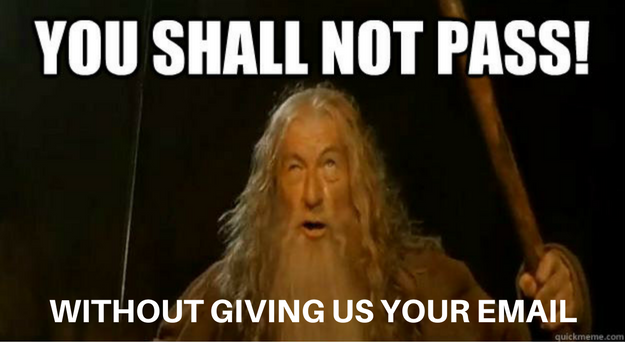But at the same time, it turned out that we had a lot of landing pages for our offers -- the gates, if you will, that weren’t getting much organic search traffic. That would mean phasing out PDFs, and replacing them with new HTML site pages with offer content optimized for both search and conversions. Does Un-gating Offers Improve SEO and Conversion Rate Optimization? The Conversion Rate Optimization (CRO) Test Hypothesis: If we un-gate offer pages and then gate the content with a on-page form that triggers on scroll, the net conversions will exceed the PDF versions of the pages. Objective: Increase organic traffic and conversion rate on new site pages to meet or surpass net conversions of original landing pages. Version B: A partially un-gated version of the page, where users start reading the offer, scrolling to a point on the page where the content blurs and they're greeted with an interstitial form, which they’d have to fill out to continue reading the content on the page. The Results In the end, we were only able to increase organic search traffic and Google SERP ranking to the pages that were already performing well for organic search -- and, therefore, had pre-existing search authority. The Conversion Rate Optimization (CRO) Test Truth time: We failed to optimize these pages for conversion to the point where they even came close to matching -- much less surpassing -- the net conversions of the original landing pages. From an organic standpoint, then, one might conclude that we should focus on un-gating only the offers that are already generating significant organic traffic, and have pre-existing search authority. As for the CRO site, clearly, the partial gating template didn’t work for conversions.

Whether you love ‘em or hate ‘em, chances are, you have an opinion about forms.
Trust us — they’re not evil. We still use them, and still believe that many marketers should continue to do so, too. But truth be told, the “Should we gate our content?” question has been flying around HubSpot for a few years now. We’ve looked at the topic through various lenses, from SEO, to lead generation, to channel-specific implications.
After all, gated offers tend to provide fairly consistent lead volume and lead-to-customer conversion rates.
But at the same time, it turned out that we had a lot of landing pages for our offers — the gates, if you will, that weren’t getting much organic search traffic. We might have been optimizing the landing pages for search, but we weren’t doing the same for the juicy, valuable, in-depth content inside the offer itself.

We had a lot of questions. Among them:
- Is locking all that valuable content behind a landing page and disallowing Google from ranking it ultimately hurting us from an SEO standpoint?
- Are PDFs dying as a format?
- Is there a way we can get people to convert on our offers when they live directly on a webpage?
Then, we thought, maybe we could find a best-of-both-worlds scenario. Maybe, if we took an SEO-heavy approach to un-gating our content, we would find ourselves with more keyword-optimized indexed pages that could appear in search engine results pages. The idea: a partially un-gated version of the page, where users could scroll to a certain point, and have to fill out a form to “unlock” the rest of the content. That would mean phasing out PDFs, and replacing them with new HTML site pages with offer content optimized for both search and conversions.
And so, we designed an experiment to answer the question: Will the combination of more organic traffic + smarter conversion assets on HTML pages lead to net better organic conversions?
We split this experiment into two parts. Below is an overview of Part I — stay tuned for Part II.
Does Un-gating Offers Improve SEO and Conversion Rate Optimization?
The Hypothesis and Objective
We hypothesized that, with these variations, Google would have enough content to crawl on these new HTML pages to give it a significant SEO boost — but that by partially gating the content, we could still generate leads from it.
We were interested to see how the lead volume would change here, which was easy to measure, but we also wanted to know would affect user experience — which was a little tougher to measure.
So, we had two pillars to the experiment, each with its own sub-hypothesis.
Hypothesis: We have a lot of offer landing pages that aren’t getting much organic search traffic. By un-gating these offers, we’ll be able to increase organic search traffic.
Objective: Increase organic search traffic and Google search engine results page (SERP) ranking of offer content.
The Conversion Rate Optimization (CRO) Test
Hypothesis: If we un-gate offer pages and then gate the content with a on-page form that triggers on scroll, the net conversions will exceed the PDF versions of the pages.
Objective: Increase organic traffic and conversion rate on new site pages to meet or surpass net conversions of original landing pages.
The Experiment
Choosing What to Un-gate
To start, we organized all of HubSpot’s current offers into broader topic categories. Then, we looked at data from each offer to see how much of the following it was generating:
- Net-new leads
- Opportunities
- Customers
That helped us determine which of the offers (and overarching topics)…

COMMENTS